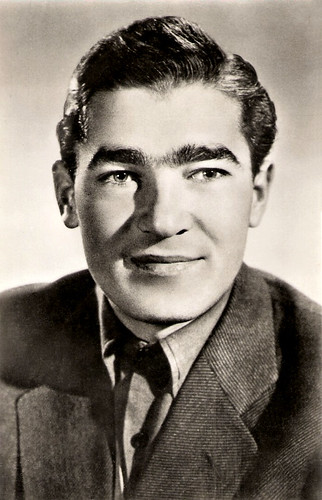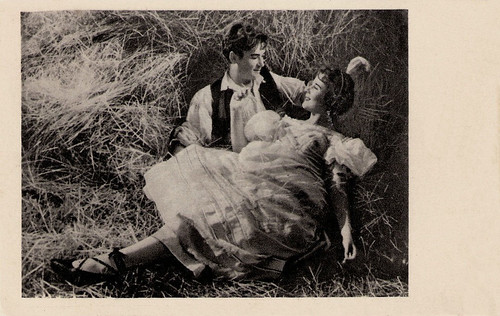Imre Soós (1930 - 1957) was the Hungarian James Dean. He had a comet-like film career and appeared in fourteen films between 1948 and 1956. After this short but successful film career, he committed suicide in 1957.
Image may be NSFW.
Clik here to view.
East-German starcard by VEB Progress Film-Vertrieb, Berlin, no. 152. Retail price: 0,20 DM. Photo: Magyar-Film.
Intense Acting
Imre Soós was born in Balmazújváros, Hungary, in 1930. He was the son of a poor family, but he got the chance to study from 1948 till 1952 at the theatre and film academy in Budapest. After his graduation he worked at the Theater in Debrecen. His intensive acting and strong stage presence, for example as Romeo, made the sensitive young actor a star. In 1954 he won the Jászai Award. Later he was a member of the company of the Madách Theater in Budapest. Imre Soós also had a comet-like film career. He started as an intern in the newly nationalized Hungarian film industry. Their first film was also Soós' film debut, Tapalatnyl Fold/The Soil Under Your Foot (1948, Frigyes Bán). Tapalatnyl Fold segues from a love story to a celebration of the People's Republic set up by Hungary's postwar communist government. In his next film, Lúdas Matyi/Mattie the Goose-boy (1950, Kálmán Nádasdy, László Ranódy), he already played the lead opposite Éva Ruttkay. The film was inspired by Mihaly Fazekas' epic poem. Soós featured as Matyi, who tries to sell his geese at the market, but runs into trouble with the servants of the local squire. The plot revolves around Matyi's scheme to get back at the squire. Lúdas Matyi was the first film made in Gezacolor. Hal Erickson at AllMovie: "Goose Boy was filmed in Gezacolor, a European color process that rendered pleasing exterior views, but was somewhat lacking when used indoors. Goose Boy might have fared better in the U.S. with stronger names in the leading roles.".
Image may be NSFW.
Clik here to view.
Hungarian postcard by Képzömüvészeti Alap Kiadóvállata, Budapest, no. 331/12/564. Photo: Saphir. Publicity still for Liliomfi (1954, Károly Makk).
Dream Couple
Between 1949 and 1953 communist propaganda films were common in Hungary. Imre Soós appeared in the quite watchable communist propaganda film Dalolva szép az élet/ Singing beautiful life(1950, Márton Keleti), the musical Állami áruház/State Department Store (1953, Viktor Gertler), and Kiskrajcár/Girls From Today (1953, Márton Keleti), the Hungarian entry into the 1954 Cannes Film Festival. In Liliomfi (1954, Károly Makk) he appeared again as a couple with Éva Ruttkay. This comedy was entered into the 1955 Cannes Film Festival, where Károly Makk won a Golden Palm for his direction. In 1955 Mari Töröcsik and Imre Soós were the dream couple of Körhinta/Merry-Go-Round (1956, Zoltán Fábri). This lyrical love story was Hungary's primary entry in the Cannes Film Festival of 1956. It became the first international success of the post-war Hungarian Cinema. Körhinta is a timeless classic with unforgettably beautiful images and equally memorable acting of Soós and Törőcsik. The ride of the two lovers on the merry-go-round ranks among the classic sequences in international cinematography. Körhinta was voted as one of the '12 Best Hungarian Films 1948-1968' by Hungarian filmmakers and critics in 1968 and then again as one of the '12 Best Hungarian Films' in 2000.
Image may be NSFW.
Clik here to view.
Hungarian postcard by Képzömüvészeti Alap Kiadóvállata, Budapest, no. 331/12/564. Retail price: 60 fillér. Photo: Saphir. Publicity still for Liliomfi (1954, Károly Makk) with Imre Soós and Éva Ruttkay.
Double SuicideKörhinta was to be the last film of Imre Soós. In June 1957 the troubled Imre Soós committed suicide together with his wife Hedvig Kenyesi. Why? The year 1956 ended with an uprising in October of the Hungarians against the Soviets, then the Soviet tanks rolled in and the resulting oppression is history. Was this the reason for the double suicide? Wikipedia in their excellent bio of Soós: "The media of the time, highly motivated by politics, dealt with him in varying pace. If the instructed subject was fitting to Soós, he was over-popularized, when the government's focus was elsewhere, he was completely omitted. This constant change of values weighted heavily on the actor, questioning his own worth, despite national and international success, the latter ignored by newspapers. Trying to bury himself with work, and to meet more and more expectations, he slowly sank into depression, along with drug usage and alcohol problems. His state become worse when his love, Violetta Ferrari left the country in 1956, and he was denied to travel to the Moscow World Festival of Youth of 1957, the era's only legal meeting place for youth of East and West. Under hospital treatment after a failed suicide attempt, he falls in love with his doctor, Hedvig Perjési, leading to a passionate and rough relationship. A few weeks after their marriage, the couple was found dead on 20 June 1957. Authorities interpreted the tragedy as double suicide, but a number of clues like Soós scratching the wall until his fingernails bled were hinting to a number of possible scenarios, including an accidental event, or murder. The short investigation drew no further conclusions, leaving ground for several myths and conspiration theories." The sad end of what appeared to be such a promising career.
Violetta Ferrari and Imre Soós in Dalolva szép az élet (1950). Opera singer József Simándy sings the aria Hazám, hazám from Ferenc Erkel's opera Bánk bán. Source: Csuberda (YouTube).
Mari Töröcsik and Imre Soós share an illicit dance in Körhinta/Merry-Go-Round (1956). Source: Yahlliw (YouTube).
Sources: Hal Erickson (AllMovie), Wikipedia and IMDb.
Image may be NSFW.
Clik here to view.

East-German starcard by VEB Progress Film-Vertrieb, Berlin, no. 152. Retail price: 0,20 DM. Photo: Magyar-Film.
Intense Acting
Imre Soós was born in Balmazújváros, Hungary, in 1930. He was the son of a poor family, but he got the chance to study from 1948 till 1952 at the theatre and film academy in Budapest. After his graduation he worked at the Theater in Debrecen. His intensive acting and strong stage presence, for example as Romeo, made the sensitive young actor a star. In 1954 he won the Jászai Award. Later he was a member of the company of the Madách Theater in Budapest. Imre Soós also had a comet-like film career. He started as an intern in the newly nationalized Hungarian film industry. Their first film was also Soós' film debut, Tapalatnyl Fold/The Soil Under Your Foot (1948, Frigyes Bán). Tapalatnyl Fold segues from a love story to a celebration of the People's Republic set up by Hungary's postwar communist government. In his next film, Lúdas Matyi/Mattie the Goose-boy (1950, Kálmán Nádasdy, László Ranódy), he already played the lead opposite Éva Ruttkay. The film was inspired by Mihaly Fazekas' epic poem. Soós featured as Matyi, who tries to sell his geese at the market, but runs into trouble with the servants of the local squire. The plot revolves around Matyi's scheme to get back at the squire. Lúdas Matyi was the first film made in Gezacolor. Hal Erickson at AllMovie: "Goose Boy was filmed in Gezacolor, a European color process that rendered pleasing exterior views, but was somewhat lacking when used indoors. Goose Boy might have fared better in the U.S. with stronger names in the leading roles.".
Image may be NSFW.
Clik here to view.

Hungarian postcard by Képzömüvészeti Alap Kiadóvállata, Budapest, no. 331/12/564. Photo: Saphir. Publicity still for Liliomfi (1954, Károly Makk).
Dream Couple
Between 1949 and 1953 communist propaganda films were common in Hungary. Imre Soós appeared in the quite watchable communist propaganda film Dalolva szép az élet/ Singing beautiful life(1950, Márton Keleti), the musical Állami áruház/State Department Store (1953, Viktor Gertler), and Kiskrajcár/Girls From Today (1953, Márton Keleti), the Hungarian entry into the 1954 Cannes Film Festival. In Liliomfi (1954, Károly Makk) he appeared again as a couple with Éva Ruttkay. This comedy was entered into the 1955 Cannes Film Festival, where Károly Makk won a Golden Palm for his direction. In 1955 Mari Töröcsik and Imre Soós were the dream couple of Körhinta/Merry-Go-Round (1956, Zoltán Fábri). This lyrical love story was Hungary's primary entry in the Cannes Film Festival of 1956. It became the first international success of the post-war Hungarian Cinema. Körhinta is a timeless classic with unforgettably beautiful images and equally memorable acting of Soós and Törőcsik. The ride of the two lovers on the merry-go-round ranks among the classic sequences in international cinematography. Körhinta was voted as one of the '12 Best Hungarian Films 1948-1968' by Hungarian filmmakers and critics in 1968 and then again as one of the '12 Best Hungarian Films' in 2000.
Image may be NSFW.
Clik here to view.

Hungarian postcard by Képzömüvészeti Alap Kiadóvállata, Budapest, no. 331/12/564. Retail price: 60 fillér. Photo: Saphir. Publicity still for Liliomfi (1954, Károly Makk) with Imre Soós and Éva Ruttkay.
Double SuicideKörhinta was to be the last film of Imre Soós. In June 1957 the troubled Imre Soós committed suicide together with his wife Hedvig Kenyesi. Why? The year 1956 ended with an uprising in October of the Hungarians against the Soviets, then the Soviet tanks rolled in and the resulting oppression is history. Was this the reason for the double suicide? Wikipedia in their excellent bio of Soós: "The media of the time, highly motivated by politics, dealt with him in varying pace. If the instructed subject was fitting to Soós, he was over-popularized, when the government's focus was elsewhere, he was completely omitted. This constant change of values weighted heavily on the actor, questioning his own worth, despite national and international success, the latter ignored by newspapers. Trying to bury himself with work, and to meet more and more expectations, he slowly sank into depression, along with drug usage and alcohol problems. His state become worse when his love, Violetta Ferrari left the country in 1956, and he was denied to travel to the Moscow World Festival of Youth of 1957, the era's only legal meeting place for youth of East and West. Under hospital treatment after a failed suicide attempt, he falls in love with his doctor, Hedvig Perjési, leading to a passionate and rough relationship. A few weeks after their marriage, the couple was found dead on 20 June 1957. Authorities interpreted the tragedy as double suicide, but a number of clues like Soós scratching the wall until his fingernails bled were hinting to a number of possible scenarios, including an accidental event, or murder. The short investigation drew no further conclusions, leaving ground for several myths and conspiration theories." The sad end of what appeared to be such a promising career.
Violetta Ferrari and Imre Soós in Dalolva szép az élet (1950). Opera singer József Simándy sings the aria Hazám, hazám from Ferenc Erkel's opera Bánk bán. Source: Csuberda (YouTube).
Mari Töröcsik and Imre Soós share an illicit dance in Körhinta/Merry-Go-Round (1956). Source: Yahlliw (YouTube).
Sources: Hal Erickson (AllMovie), Wikipedia and IMDb.